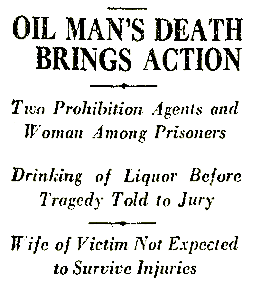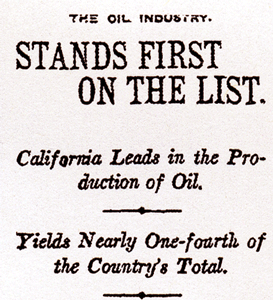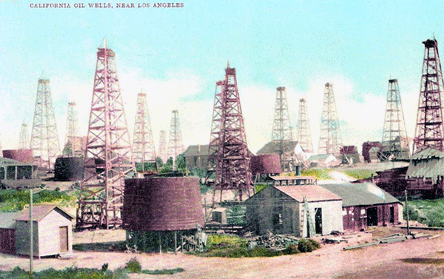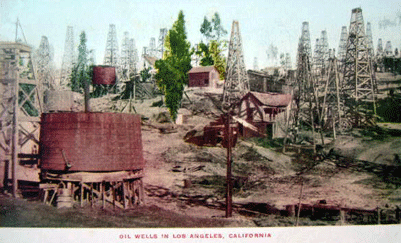April 7, 1927
Los Angeles
A Coroner’s inquest commenced today in an effort to determine just what happened when two inebriates—Frank Farley and George H. Hudson—pixilatedly plowed their car head-on into the auto driven by Union Oil bigwig E. Percy Ingmire & wife near Wilmington. Two things are certain: Ingmire is dead, and the two sots being held for murder are Prohibition Agents, drunkenly driving a government car on government business.
Seems our Boys of the Eighteenth, Farley and Hudson, were out carousing (with liquor in the car on the wrong side of the road and with excessive speed) in the company of three seamen from the steamer Pomona and a Mrs. Margaret “Bessie” McCallister (at whose home they’d earlier had a drinking party) when the accident occurred.  Normally, drunken vehicular homicides under the auspices of Volstead-Feds get swept under the rug, but unfortunately Ingmire was former president of the San Pedro Chamber of Commerce, Past Master of the San Pedro Masonic Lodge, Past Exalted Ruler of San Pedro Elks’ Lodge, President of the San Pedro Industrial Association, ad infinitum. As such, all and sundry jumped into the fray: the DA appeared for the State, the Dep US Atty for the Feds, the prohibition administrators for themselves—the last of which entering into a fray with folks from the Customs Dept, who are fond of hampering prohibition enforcement in California. (The Department of Justice and the Intelligence Section of the Treasury Department are on deck.)
Normally, drunken vehicular homicides under the auspices of Volstead-Feds get swept under the rug, but unfortunately Ingmire was former president of the San Pedro Chamber of Commerce, Past Master of the San Pedro Masonic Lodge, Past Exalted Ruler of San Pedro Elks’ Lodge, President of the San Pedro Industrial Association, ad infinitum. As such, all and sundry jumped into the fray: the DA appeared for the State, the Dep US Atty for the Feds, the prohibition administrators for themselves—the last of which entering into a fray with folks from the Customs Dept, who are fond of hampering prohibition enforcement in California. (The Department of Justice and the Intelligence Section of the Treasury Department are on deck.)
Dry Agent Farley, driver of the killer flivver, is a real catch. He had been arrested for a street holdup in 1923, was caught sneaking onto the Dutch steamer Eemdyk looking for booze (outside the official capacity of his employment, that is) and, according to Customs officials, was often insolent and acted beyond his authority. Of course, those Wet Agents from Customs would say that.

On September 20, a US District Judge gave Farley one to ten in San Quentin. Of course, the Federal Comptroller refused to pay Farley’s railroad fare to Q, on the grounds that Farley was a State Prisoner. The State controller stated that Farley is a Federal prisoner and if anyone was going to pay his fare, it was the Feds. So Farley stayed a spell in County, where he made pals with one Maj. Donald McRae, on trial for robbing government liquor warehouses. Inside County they got liquor all the time, until Farley went up north and subsequently testified about his involvement in McRae’s phony alibis, whereafter McRae threatened his life. And so go our drunken, fallen Feds.


 Normally, drunken vehicular homicides under the auspices of Volstead-Feds get swept under the rug, but unfortunately Ingmire was former president of the
Normally, drunken vehicular homicides under the auspices of Volstead-Feds get swept under the rug, but unfortunately Ingmire was former president of the 



